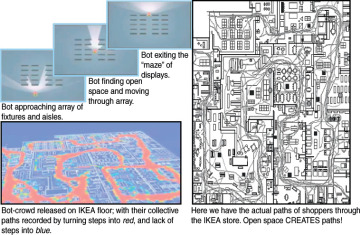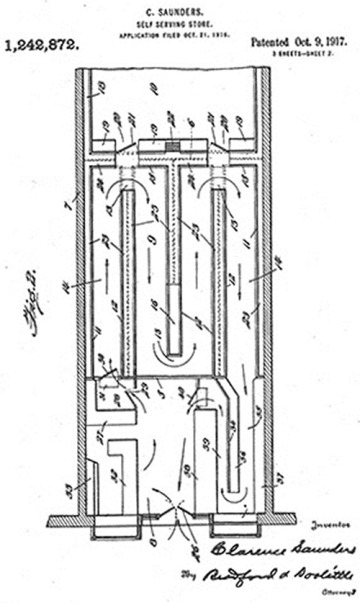- Bidirectional Search
- Products/Shoppers Competition
- Open Space Actually Attracts Shoppers--Think Navigation!
- Review Questions
Open Space Actually Attracts Shoppers—Think Navigation!
The third idea that supports navigability of the store is that shoppers are subconsciously drawn to open space. This happens because shoppers shop through their eyes. They do not look for products through careful, rational thinking, but by habit and instinct. This is why I often urge, “If the shopper does not see it, it’s effectively not in the store.” The shopper sees only a small fraction of the store up close and personal. If you are going to manage the sales process, you better know what that small fraction is.
Everything about store design is about seeing. An ideal store design includes a wide, open track that circumnavigates the store. Low displays on at least one side of that track allow a wide vista so that shoppers see to the furthest areas of the store. It’s okay for shoppers to see lots of merchandise at a distance. Let the shopper go that distance if that merchandise resonates with them. Don’t jam it all into their faces, limiting their ability to see more of the store and more available products. See Chapter 3 of this book.
Professor Allen Penn of the University College of London showed exactly how open space moves shoppers around the store.3 Professor Penn and one of his students ingeniously illustrated how shoppers respond to the space in an IKEA floor plan by creating a model store that consisted of only floor space and blank blocks representing the displays and fixtures. (Upper left of Figure I.3) They then sent bots programed to seek out open spaces through the floor plan. Here you can see how their open-space sensitive bots created the exact same paths that real shoppers walked in the real, fully stocked store:

Figure I.3 Open space driving the shoppers’ navigation. (Images provided by Professor Alan Penn, UCL.)
In the upper-left of Figure I.3, you see three successive scenes of a bot approaching an array of shelf displays that block vision, with seeable open spaces indicated by the lights penetrating the array. The bot moves in the direction of the most light and seeable space and makes its way to the widest aisle, and down that to the exit of the array of displays.
On the lower-left you see this principle applied with a crowd of these bots making their way through an IKEA store model with fixtures matching a real store. The steps of the bots on the floor turns the floor redder, and areas where they don’t step, over time, turn bluer. On the right, the white lines on the same floor plan is the recorded paths of actual shoppers in the real IKEA store. Open space drives the paths of the shoppers. There may be multiple major paths, but all of them will have the characteristic of wide visual accessibility.
We have discussed three ideas that should drive store design and impact selection at the shelf:
Bidirectional search—Products search for shoppers; shoppers search for products.
Products/shoppers compete for space—They occupy interfacing spaces.
Open space actually attracts shoppers—Think navigation!
We have recognized and appreciated these principles before, but we have not recognized them as part of the mosaic of shopping, and particularly navigation, in the store. This reminds me of something J. R. R. Tolkien observed about a beautiful painting that you might buy and hang in a prominent place for your regular enjoyment. As time goes by, and you see it again and again, the painting gradually fades from your consciousness, until, possibly, a guest seeing it for the first time exclaims, “What a beautiful painting!” And then you look at it anew and say, “Yes, it is quite lovely!”
This principle applies to the wonder and joy of this incredible thing we have, self-service retailing, which came into being only about 100 years ago. It had a massive and positive global impact for consumers, retailers, and their suppliers. In fact, a century ago, some people understood the glories of self-service retail going on around them, and didn't just see it as “pile it high, and let it fly!” In 1916, an American visionary filed a patent for a self-serving store.4 You can still find that spirit of innovation and efficiency today.5 (See also: The “Path-to-Purchase” is Often a U-Turn6.)
For retailers, the reduction or elimination of their sales team/staff, meant that their focus moved to logistics, supplier management/negotiations, and matching merchandise selection with their shoppers. No real selling was needed. Again, self-service means, “shopper, sell yourself.” But the death of retailer selling (as contrasted with merchandising) was resisted by a few retailers. One in particular, Clarence Saunders, continually pressed for more efficiency in selling, and patented the store design represented here:
Notice the vestibule area at the front of the store, where shoppers can enter the display area, on the left, and pass in a serpentine path up and down a series of aisles. The purpose of this serpentine path was to allow the merchant to introduce the shopper to an “appropriate” offering of merchandise in a systematic way. In this way, Clarence Saunders retained control of the selling process, and was able to assist the shopper with their purchases. In effect, in these serpentine stores, the retailer assumed responsibility for selling, to an extent, instead of passively abdicating this responsibility for the sale to the shopper.
Obviously, instead of following this lead, retailers the world over abandoned Saunders' serpentine path, multiplied aisles, for which manufacturers generously rewarded them, and turned shoppers loose, to their own devices, in mini-warehouses. Retailers became passive in the process of shoppers making purchase decisions, essentially allowing selling skills to atrophy.
It is no wonder shoppers waste 80% of their time in the store, wandering about seeking something to buy - not to mention vast options when they finally arrive in an area where a purchase will actually occur. But there are modern incarnations of the serpentine store. Ikea is probably the best known global example. But for the CPG/FMCG market the pre-eminent example is Stew Leonards, where they achieve something like $100 million in sales with the serpentine path.5
By studying that history, and by measuring everything going on in the store, I like to think we have scraped the dull overfamiliarity off of this marvelous painting, to once again stand in awe at the view. It might seem odd that it would take a scientist, mindful of Lord Kelvin's dictum, “If you cannot express your knowledge in numbers, it is of a meager and unsatisfactory sort!” to understand the art of modern self-service retailing. But I am hoping an increasing number of fellow viewers will delight in the perspective—to see the obvious, again, possibly for the very first time.
My colleague, Mark Heckman, and I are getting closer to rolling out a comprehensive retail management system we call Accelerated Merchandising. Thinking things through from scratch again—in particular, putting the science of retailing into an historical perspective—has been a privilege. Every principle discovered can be validated by the successes and failures of the past 100 years, and accounts for the rise and fall of the retail giants in our own time. We believe it shows the way from where we are today to increased performance for all self-service retailers, both bricks and online, going forward. Here we want to share a significantly different view of the self-service sales process going on in stores around the world. I hope you find this useful to your own thinking!

